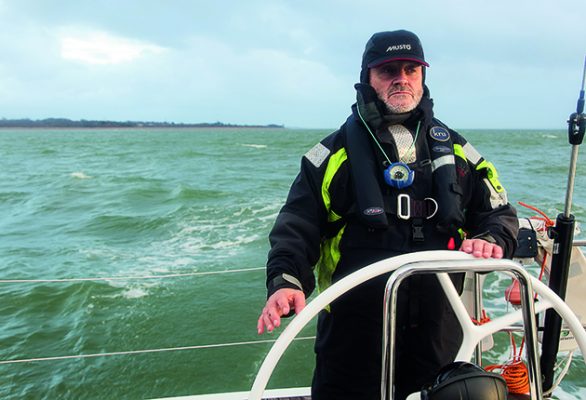Deck harnesses for children, mainsail downhaul trick and soft shackle splicing are amongst the skippers' tips suggested by seasoned sailors and Yachting Monthly experts
The versatile soft shackle

Keep soft shackles and loops in the cockpit so they are available immediately. Credit: Patricia & Julian Morgan
We find endless uses for loops and soft shackles, which we make from various sizes of 12-strand single braid Dyneema.

Julian and Patricia Morgan left the UK in September 2017 to sail around the world on their Allures 45.9. Credit: Julian & Patricia Morgan
In Tonga last year, we managed to make a temporary repair to a friend’s broken lower shroud using a length of 6mm Dyneema which we carry on board for just this situation.
We’ve also use a soft shackle or loop to attach sheets to sails and snatch blocks to deck fittings.
A soft shackle is strong, light and so much kinder to the boat than stainless steel.
We hang soft shackles and loops on the grab handles of our cockpit table where they are available for immediate deployment when needed.
Continues below…
How to tie a soft shackle
Soft shackles can be used almost anywhere you currently use a conventional shackle. Look on any boat and you will…
We Tested 16 of the Best Lifejackets for Boating and Sailing
We all have lifejackets on board, but do you know what yours is actually like to use? We test 10…
Skippers tips: Adapt your boat & prevent corrosion
Yachting Monthly experts and seasoned skippers share their advice on a whole range of issues for the cruising sailor. Do…
Skippers’ Tips: Replacing jack stays & rudder checks
Yachting Monthly experts and seasoned skippers share their advice on a whole range of issues for the cruising sailor. Do…
Our tip is that cruisers obtain some lengths of 12-strand Dyneema (we use SK78) and practise making shackles, loops and splices; 4 and 6mm Dyneema are great for most purposes and 8mm is also very handy where more strength is required.
Make sure you purchase your Dyneema from a reputable supplier as there are plenty of dubious-quality products for sale on the internet.
We have found Jan-Willem Polman’s book Splicing Modern Ropes a very useful resource to have on board.
Julian and Patricia Morgan
Invest in an exhaust sensor

A blocked raw water inlet can be detected by fitting exhaust temperature sensors
Sooner or later you’ll have a blocked raw water inlet on your engine.
Rachael Sprot is a Yachtmaster ocean instructor and director of Rubicon 3, the offshore yacht sailing school
But by the time the engine overheat alarm has gone off, the engine will already be seriously hot.
Depending on how quickly you turn your engine off it might have spat out its coolant, shredded the impeller or the dry exhaust gases could have damaged the rubber exhaust hose, which is designed to be water cooled.
Either way, it’s not a 30-second fix – clearing the blockage can be fairly quick but you often have to wait for the engine to cool down before you can top up fluid levels.
We fitted exhaust temperature sensors to all our engines that alarm instantly if there’s a restriction to the raw water flow, and long before the engine overheats.
This allows you to clear the blockage in the system before any further damage is done.
Rachael Sprot
Mainsail downhaul

A downhaul line can help with pulling down the main. Credit: Randall Reeves
On heavy-weather solo passages aboard my 45ft aluminum sloop Mo, I rig a downhaul in the main, essentially a line fixed at the gooseneck that runs up through the top-most reef

Randall Reeves is the first sailor to circumnavigate the American and Antarctic continents in one season. Credit: Randall Reeves
cringle tack and back to the mast.
With a good wind in its belly, the main can be a bugger to get down, even with slippery Harken cars.
The downhaul ensures I get the sail down in a timely manner.
Randall Reeves
Consider a harness not a lifejacket

A child will be more comfortable in a harness than a bulky lifejacket. Credit: Graham Snook

Graham Snook is a photographer and journalist who has been testing yachts and gear for over 20 years. He cruises a Sadler 32 from Gosport. Credit: Graham Snook
There is a time and a place for lifejackets, and children should wear them in dinghies and when close to the water.
On a yacht, however, wearing a lifejacket while sailing can be unwieldy and uncomfortable, and if your child isn’t happy, neither are you.
A better solution is a child’s safety harness.
Attach a short tether and they won’t be able to leave the cockpit but they’ll still be able to roam safely.
Harnesses can also be worn below decks, giving your child the freedom to go below without having to extricate themselves from the jacket only to have to put it back on when they change their mind.
Graham Snook
Make the most of your locker space

Search for your cockpit lockers’ hidden space. Credit: Graham Snook
Many yachts have cockpit lockers that reach up high into the cockpit coamings, but few owners make the most of this space.
Tucking a liferaft up there isn’t sensible, but if you keep your fenders in a locker, start by tucking the first few to the back and standing them upright.
Graham Snook








